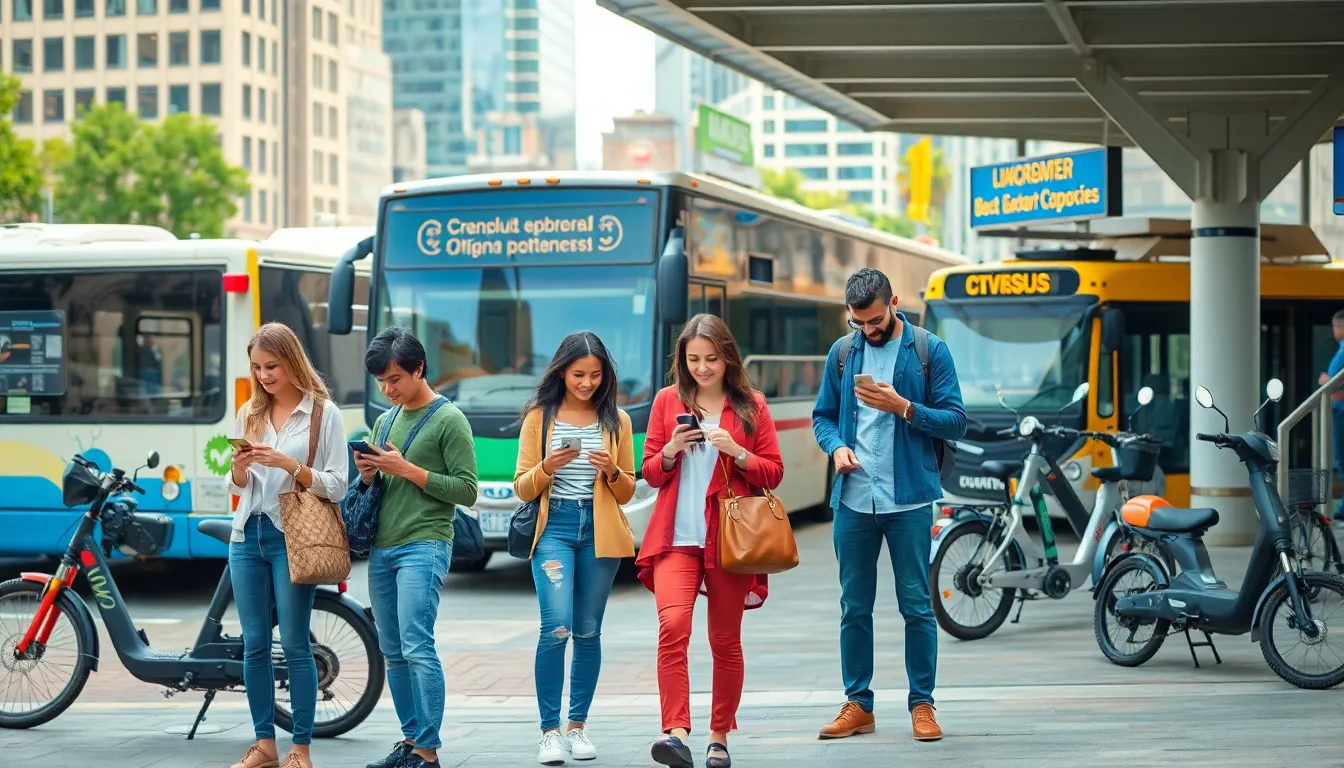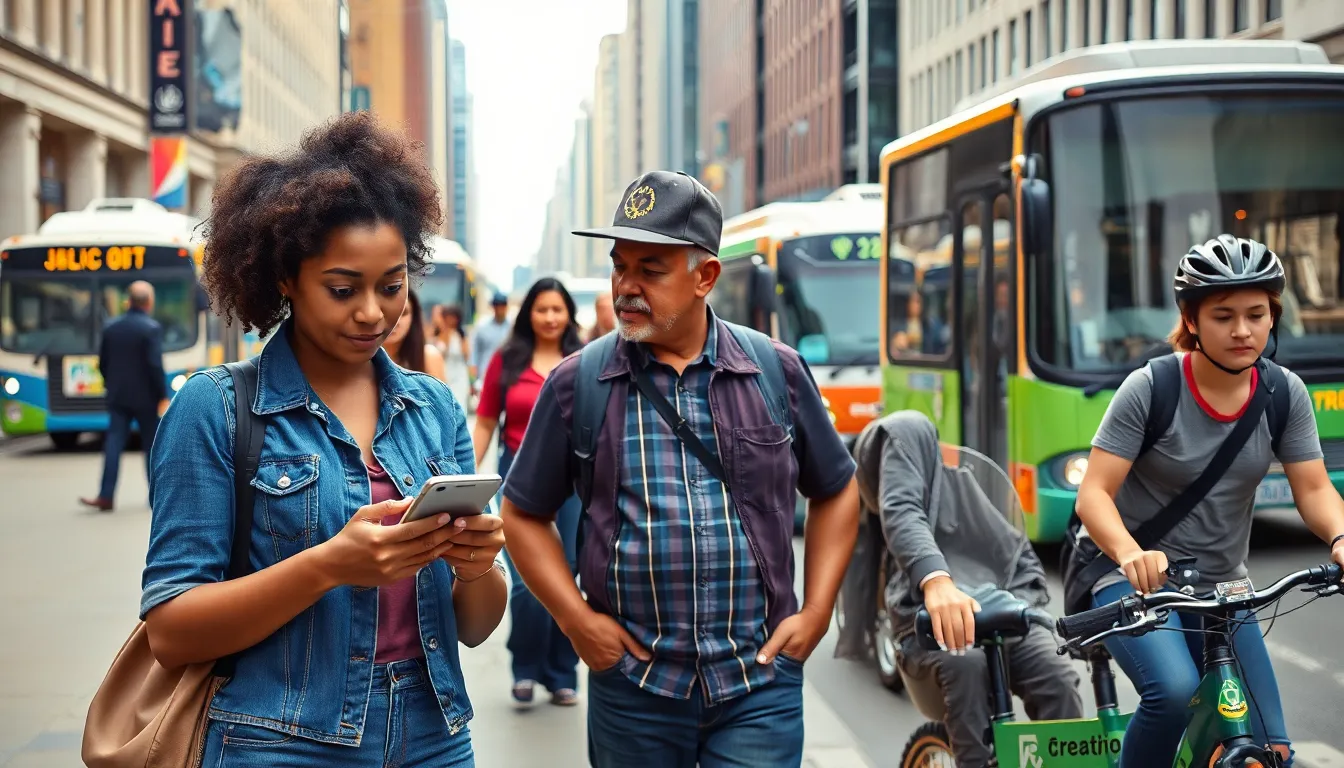Imagine a world where getting from point A to point B is as easy as ordering a pizza. That’s the magic of Mobility as a Service (MaaS). It’s not just a fancy buzzword; it’s a game-changer for urban transportation. Gone are the days of juggling multiple apps for rides, public transport, and bike rentals. With MaaS, everything’s bundled together like a well-crafted burrito—convenient and satisfying.
Table of Contents
ToggleUnderstanding Mobility As A Service
Mobility as a Service (MaaS) transforms how individuals navigate urban environments. This system integrates multiple transportation services, creating seamless travel experiences.
Definition and Concept
MaaS represents a shift from traditional transport models to user-centric solutions. It delivers flexibility and convenience, allowing users to access diverse transport options through a single platform. Users can compare and choose services based on parameters like price and time. The MaaS framework encourages multimodal travel, promoting a more sustainable urban ecosystem.
Key Components
Key components of MaaS include platforms, service providers, and data integration. Platforms consolidate various services, enabling users to plan journeys without navigating multiple apps. Service providers encompass transportation modes such as buses, rideshares, or bike rentals. Effective data integration ensures real-time updates and accurate pricing, enhancing user experience. Each component contributes to the overall functionality and appeal of MaaS, making urban mobility more efficient.
Benefits of Mobility As A Service

MaaS offers significant advantages that transform urban transportation experiences.
Enhanced User Experience
MaaS provides improved convenience for travelers. Users can access multiple transportation options through a single platform, eliminating the need to manage separate apps or payment methods. Seamless navigation between different transport modalities enhances overall satisfaction. Personalized recommendations based on travel patterns further improve the user journey. Real-time updates allow individuals to make informed decisions, avoiding delays and enhancing travel efficiency. With integrated planning tools, users can easily map out the best routes, making their journeys smooth.
Environmental Impact
MaaS contributes positively to the urban environment. By promoting multimodal travel, it reduces reliance on single-occupancy vehicles. A shift to shared transport options decreases overall traffic congestion, leading to lower carbon emissions. Public transport options become more appealing through easy access and optimized connections. Encouraging alternative modes of transport, like bike rentals or electric scooters, further supports sustainability. Collectively, these benefits help create greener urban landscapes.
Challenges and Considerations
Mobility as a Service (MaaS) faces several challenges that need addressing for successful implementation. Integrating various transportation systems presents significant complexities.
Integration with Existing Systems
Integration with existing systems poses technical hurdles. Many transportation providers use diverse platforms and technologies, complicating service consolidation. Standardizing these platforms ensures seamless data sharing among different services. Maintenance also requires ongoing support to adapt to evolving user needs. Coordination with local governments and infrastructure providers remains essential for creating cohesive travel options. Successful integration relies on effective partnerships across public and private sectors.
Data Privacy and Security
Data privacy and security represent critical issues in MaaS implementation. Users’ personal information, including travel patterns and payment details, must remain protected. Companies need robust encryption and security protocols to mitigate risks. Compliance with regulations, such as GDPR, is crucial in ensuring user trust. Anonymizing user data can enhance privacy while still allowing service providers to analyze trends. Establishing transparency in data usage fosters confidence among users, promoting wider adoption of MaaS solutions.
Case Studies in Mobility As A Service
Mobility as a Service showcases numerous examples of successful implementations, demonstrating its transformative potential in urban transportation.
Successful Implementations
City of Helsinki embraced MaaS with its Whim app. Users access public transportation, taxis, and bike-sharing through a single platform. The city’s seamless integration simplifies travel planning and payment processes. In Los Angeles, the GoLA app connects various transport modes, including buses, bike rentals, and ride-sharing services. This approach enhances user experience and promotes multimodal travel. Furthermore, a partnership between Uber and public transit agencies in several cities enables users to plan and pay for rides directly through the Uber app. Such collaborations highlight the importance of integrating traditional transport with on-demand services to maximize efficiency.
Lessons Learned
Implementing MaaS reveals critical insights that can guide future projects. Coordination between transport providers and local governments is essential for creating a user-friendly ecosystem. Challenges often arise from integrating different technologies and platforms. Establishing clear communication channels and standardized data-sharing protocols aids in overcoming these obstacles. Moreover, understanding user preferences through data analysis enhances service customization. Prioritizing data privacy and security measures builds user trust, ensuring wider adoption in diverse communities. Addressing these fundamental aspects contributes significantly to the success of Mobility as a Service initiatives.
Future Trends in Mobility As A Service
The future of Mobility as a Service (MaaS) relies on continuous innovation and evolving policies. These trends shape how urban transportation networks operate and provide user experiences.
Technology Innovations
Innovations in technology play a pivotal role in enhancing MaaS. AI and machine learning improve route optimization, making journeys more efficient. Real-time data integration allows platforms to update users about delays or cancellations instantly. Blockchain technology also offers secure transactions and data management. Furthermore, advancements in electric vehicle technology promote sustainability, encouraging users to choose greener transport options. Companies adopting technology-driven strategies enjoy improved service reliability and adaptability to changing mobility needs.
Policy Implications
Policies significantly influence the implementation and expansion of MaaS. Local governments must prioritize collaborative frameworks that encourage partnerships between private and public transport providers. Regulations regarding data privacy and consumer protection also require attention, fostering user trust while safeguarding personal information. Incentives for sustainable transport options can drive greater adoption of MaaS across urban areas. Additionally, investment in infrastructure that supports multimodal transport improves connectivity, ensuring seamless travel experiences for users. Policymakers focusing on these areas create an environment conducive to the growth of MaaS initiatives.
Mobility as a Service is set to redefine urban transportation by offering a cohesive and user-friendly experience. The integration of various transport modes into a single platform not only simplifies travel but also encourages sustainable practices. As cities continue to evolve, the collaboration between public and private sectors will be crucial in overcoming challenges related to data integration and user privacy.
Investing in innovative technologies and infrastructure will pave the way for enhanced mobility solutions. By prioritizing user needs and environmental considerations, MaaS can transform how people navigate urban landscapes. As this model gains traction, it promises to create a more efficient and sustainable future for urban mobility.




